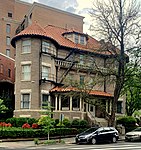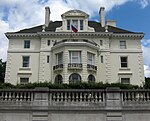Oak Lawn (Washington, D.C.)

Oak Lawn (later known as the Dean Estate, Temple Heights, and Temple Hill) was a large house and wooded estate that once stood on the edge of today's Dupont Circle and Adams Morgan neighborhoods in Washington, D.C. The estate was bounded by 19th Street, Columbia Road, Connecticut Avenue, and Florida Avenue. Previously called Widow's Mite, the estate was originally several hundred acres, but by the 19th century, had been reduced to around 10 acres (4 ha). The house was built around 1820 and was greatly expanded in 1873 by Thomas P. Morgan, one half of the eponym of the Adams Morgan neighborhood. A large oak tree, nicknamed the Treaty Oak, was reportedly hundreds of years old and stood just a few yards from the house. Oak Lawn was located on a hill. Due to its expansive views of the city, the estate was sought after by local developers. The surrounding neighborhoods evolved into bustling residential and commercial areas. However, Oak Lawn remained a wooded, undeveloped tract until the 20th century. In 1922 the land was sold to a Masonic group who wanted to build a large temple complex. However, due to the Great Depression and a lack of funds, the plan was canceled. In 1940, a local developer selected Frank Lloyd Wright to design a massive mixed-use project there (Crystal Heights) that would include 14 towers and a hotel: that project was also canceled. During the next 20 years, multiple plans for Oak Lawn never came to fulfillment. The Oak Lawn house was demolished in 1948, and the Treaty Oak cut down in 1953. In the late 1950s and early 1960s, the Washington Hilton and two commercial buildings were built on the property that had been home to the old estate.
Excerpt from the Wikipedia article Oak Lawn (Washington, D.C.) (License: CC BY-SA 3.0, Authors, Images).Oak Lawn (Washington, D.C.)
Connecticut Avenue Northwest, Washington
Geographical coordinates (GPS) Address Phone number Website Nearby Places Show on map
Geographical coordinates (GPS)
| Latitude | Longitude |
|---|---|
| N 38.916275 ° | E -77.044703 ° |
Address
Washington Hilton
Connecticut Avenue Northwest 1919
20009 Washington
District of Columbia, United States
Open on Google Maps








